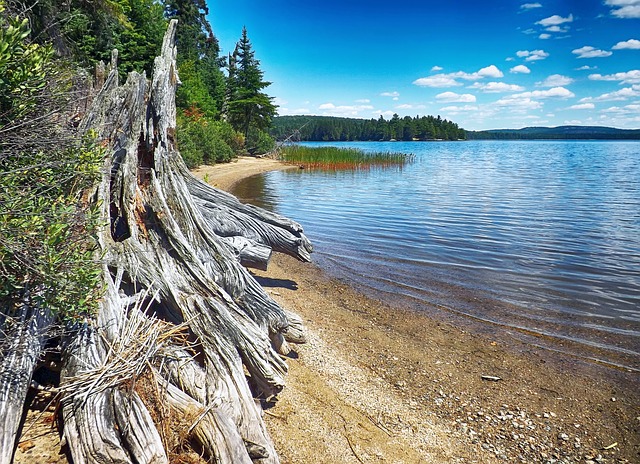With a population of more than 13 million, Ontario is home to about one in three Canadians. More than 85% live in urban centres, largely in cities on the shores of the Great Lakes.
Ontario is a very diverse province. For example, 42.8% of the population of Toronto was born outside Canada, which is the second-largest percentage of immigrants in a single city on Earth, after Miami. Hamilton is ranked the third-most diverse urbanized area in Canada (after Toronto and Vancouver).
In relation to natural increase or inter-provincial migration, immigration is a huge population growth force in Ontario, as it has been over the last two centuries. More recent sources of immigrants with already large or growing communities in Ontario include Caribbeans (Jamaicans, Trinidadians, Guyanese, and Bajan), South Asians (e.g. Pakistanis, Indians, Bangladeshis and Sri Lankans), East Asians (mostly Chinese and Filipinos), Latin Americans (such as Colombians, Mexicans, Hondurans, Argentineans, and Ecuadorians), Eastern Europeans such as Russians and Bosnians, and groups from Somalia, Iran, and West Africa. Most populations have settled in the Greater Toronto area. A smaller number have settled in other cities such as London, Kitchener, Hamilton, Windsor, Barrie, and Ottawa.
QUICK STATICTICS
- Estimated population of Ontario: 13,373,000 (2011)
- Population growth rate per year: 1.0%
- Birth Rate: 10.8/1,000 people
- Death Rate: 7.2/1,000 people
- Life Expectancy at birth: 81 years
- Infant Mortality rate: 5.2 (2006)
- Percentage of National Population: 38.7%
THE GOLDEN HORSESHOE
The Golden Horseshoe is a densely populated and industrialized region (or urban agglomeration) centered around the Greater Toronto Area at the western end of Lake Ontario in Southern Ontario, with outer boundaries stretching south to Lake Erie and north to Georgian Bay. Most of it is also part of the Quebec City – Windsor Corridor. With a population of 8.1 million people, it makes up slightly over a quarter (25.6%) of the population of Canada and contains approximately 75% of Ontario’s population, making it one of the largest population concentrations in North America. Although it is a geographically named sub-region of Southern Ontario, the Greater Golden Horseshoe is also used today to describe the metropolitan region that stretches across the area in totality including smaller centres outside of the core region.
The core of the region starts from Niagara Falls at the eastern end of the Niagara Peninsula and extends west, wrapping around the western end of Lake Ontario at Hamilton and then turning northeast to its anchor city Toronto (on the northwestern shore of Lake Ontario), before finally terminating at Oshawa, just east of Toronto. The wider region spreads inland in all directions away from the Lake Ontario shoreline, southwest to Brantford, west to the Kitchener-Waterloo area, north to Barrie, and northeast to Peterborough. The whole region’s area covers approximately 33,500km2 (13,000sq.mi), out of this, 7,300km2 (2,800sq.mi) is covered by the Greenbelt.
The phrase, “Golden Horseshoe,” was first used by Westinghouse president Herbert H. Rogge in a speech to the Hamilton Chamber of Commerce, on January 12, 1954.
ABORIGINAL PEOPLE
About 240,000 of Ontario’s people identified themselves as Aboriginal (North American Indian, Métis or Inuit). That’s about two per cent of the province’s population and about one-fifth of Canada’s Aboriginal population. They include Algonquian-speaking Cree, Oji-Cree, Algonquin, Ojibwa, Odawa, Potawatomi, and Delaware, plus the Iroquoian-speaking Six Nations (Mohawk, Oneida, Onondaga, Cayuga, Seneca and Tuscarora).
Aboriginal peoples make up 2% of the population, with two-thirds of that consisting of North American Indians and the other third consisting of Métis. The number of Aboriginal people has been increasing at rates greater than the general population of Ontario.
VISIBLE MINORITIES
Ontario is the second most diverse province in terms of visible minorities after British Columbia, with 22.8% of the population consisting of visible minorities. The Greater Toronto Area, Ottawa, Windsor, Hamilton and Waterloo Region are quite diverse metropolitan areas.
LANGUAGE, HERITAGE AND RELIGION
English is Ontario’s official language; however there are entire communities where French is as easily spoken as English, thanks to their French-Canadian history. French language rights have been extended to the legal and educational systems. Government services are provided in many designated regions across the province.
Ontario’s population growth has depended on immigration ever since the American Revolution sent Loyalists north to Canada. Even today, about half of the approximately 250,000 people who immigrate to Canada each year, choose to settle in Ontario. Toronto has been called the most multicultural city in the world, where more than 100 languages and dialects are spoken.
The five languages most commonly spoken at home are English (about eight million speakers), French (about 583,000 speakers), Chinese (about 482,000 speakers), Italian (almost 283,000 speakers) and German (about 158,000 speakers). Other significant languages include Polish, Spanish, Punjabi, Ukrainian and Portuguese.
The largest denominations by number of adherents according to the 2001 census were the Roman Catholic Church with 3,866,350 (34%); the United Church of Canada with 1,334,570 (12%); and the Anglican Church of Canada with 985,110 (9%).
LABOUR FORCE
The labour force exceeds six million people and about half of Ontario residents over the age of 25 have completed post-secondary schooling. There are 19 degree-granting institutions and 24 colleges of applied arts and technology.
CULTURE
Historically, Canada has been influenced by British, French, and aboriginal cultures and traditions. Canadian society is often depicted as being “very progressive, diverse, and multicultural”. Canada’s culture draws influences from its broad range of constituent nationalities, and policies that promote multiculturalism are constitutionally protected. As a whole, Canada is in theory a cultural mosaic – a collection of several regional, aboriginal, and ethnic subcultures.
Government policies such as publicly funded health care, higher taxation to distribute wealth, outlawing capital punishment, strong efforts to eliminate poverty, an emphasis on multiculturalism, stricter gun control, and legalization of same-sex marriage are social indicators of Canada’s political and cultural values.
Toronto has the largest variety of theatres and performing arts companies in Ontario, and the second largest in North America after New York. Dozens more fine theatres operate throughout the province. Seasonal festivals, like the Stratford Festival, the Shaw Festival and those theatres promoted by the Association of Summer Theatres ‘Round Ontario draw crowds from across Canada and the United States.
Ontario also has well known art galleries, like the Art Gallery of Ontario in Toronto, the National Gallery of Canada in Ottawa and the McMichael Canadian Art Collection in Kleinburg. In many other cities, regional galleries house fine collections and host travelling exhibitions.
ONTARIO FACT SHEET JANUARY 2012
Capital – Toronto*
| 2010 Estimated population |
5,741,419 |
| * Census Metropolitan Area |
Population
| July 1/11 |
13,372,996 |
| % of Canada |
38.8 |
| Average annual growth, 2001 – 2011 (%) |
1.2 |
| Life expectancy (years), 2007 | |
| Male |
79.0 |
| Female |
83.4 |
| Labour force (000s), 2011 |
7,302 |
| Employment (000s), 2011 |
6,731 |
| Job creation, 2011 |
121,300 |
Population Profile, 2006 (% distribution)
| Canadian born |
70.8 |
| Foreign born |
29.2 |
| Immigrated before 1991 |
15.7 |
| Immigrated between 1991 & 2006 |
12.6 |
| Non-permanent residents |
1.0 |
Age Structure
|
Age Groups |
Total |
Male |
Female |
| 0–4 years | 671,250 | 343,340 | 327,910 |
| 5–9 years | 772,650 | 396,385 | 376,265 |
| 10–14 years | 788,845 | 404,970 | 383,880 |
| 15–24 years | 1,487,835 | 754,565 | 733,270 |
| 25–34 years | 1,558,495 | 760,695 | 797,800 |
| 35–44 years | 1,959,520 | 963,840 | 995,680 |
| 45–54 years | 1,635,280 | 801,540 | 833,735 |
| 55–64 years | 1,064,000 | 520,570 | 543,430 |
| 65–74 years | 818,170 | 383,625 | 434,540 |
| 75–84 years | 503,930 | 202,270 | 301,665 |
| 85 years and over | 150,075 | 45,260 | 104,810 |
| Total | 11,410,045 | 5,577,055 | 5,832,990 |
10 Largest Census Metropolitan Areas by Population
Statistics Canada’s measure of a “metro area”, the Census Metropolitan Area (CMA), roughly bundles together population figures from the core municipality with those from “commuter” municipalities.
|
CMA (largest other included municipalities in brackets) |
2006 |
2001 |
| Toronto CMA (Mississauga, Brampton) | 5,113,149 | 4,682,897 |
| Ottawa CMA (Gatineau, Clarence-Rockland, Russell) | 1,130,761 | 1,063,664 |
| Hamilton CMA (Burlington, Grimsby) | 692,911 | 662,401 |
| London CMA (St. Thomas, Strathroy-Caradoc) | 457,720 | 435,600 |
| Kitchener CMA (Cambridge, Waterloo) | 451,235 | 414,284 |
| St. Catharines–Niagara CMA (Niagara Falls, Welland) | 390,317 | 377,009 |
| Oshawa CMA (Whitby, Clarington) | 330,594 | 296,298 |
| Windsor CMA (Lakeshore, LaSalle) | 323,342 | 307,877 |
| Barrie CA (Innisfil, Springwater) | 177,061 | 148,480 |
| Greater Sudbury CMA (Whitefish Lake & Wahnapitei Reserves) | 158,258 | 155,601 |
10 Largest Municipalities by Population
|
City |
2006 |
2001 |
| Toronto (provincial capital) | 2,503,281 | 2,481,494 |
| Ottawa (national capital) | 812,129 | 808,391 |
| Mississauga | 668,549 | 612,925 |
| Hamilton | 504,559 | 499,268 |
| London | 352,395 | 336,539 |
| Brampton | 433,806 | 325,428 |
| Markham | 261,573 | 208,615 |
| Windsor | 216,473 | 208,402 |
| Kitchener | 204,668 | 190,399 |
| Vaughan | 238,866 | 182,022 |
Ethnic Groups
|
Ethnic |
Responses |
% |
| Total population | 12,028,895 | 100 |
| English | 2,971,360 | 24.7 |
| Canadian | 2,768,870 | 23.0 |
| Scottish | 2,101,100 | 17.5 |
| Irish | 1,988,940 | 16.5 |
| French | 1,351,600 | 11.2 |
| German | 1,144,560 | 9.5 |
| Italian | 867,980 | 7.2 |
| Chinese | 644,465 | 5.4 |
| East Indian | 573,250 | 4.8 |
| Dutch (Netherlands) | 490,995 | 4.1 |
| Polish | 465,560 | 3.9 |
| Ukrainian | 336,355 | 2.8 |
| North American Indian | 317,890 | 2.6 |
| Portuguese | 282,870 | 2.4 |
| Filipino | 215,750 | 1.8 |
| British, not included
elsewhere |
205,755 | 1.7 |
| Jamaican | 197,540 | 1.6 |
| Welsh | 182,825 | 1.5 |
| Jewish | 177,255 | 1.5 |
| Russian | 167,365 | 1.4 |
| Hungarian (Magyar) | 151,750 | 1.3 |
| Spanish | 149,160 | 1.2 |
| Greek | 132,440 | 1.1 |
| American (USA) | 113,050 | 0.9 |
| Pakistani | 91,160 | 0.8 |
| Métis | 87,090 | 0.7 |
| Sri Lankan | 85,935 | 0.7 |
| Vietnamese | 83,330 | 0.7 |
| Romanian | 80,710 | 0.7 |
| African, not included elsewhere | 75,500 | 0.6 |
| Finnish | 72,990 | 0.6 |
| Korean | 72,065 | 0.6 |
| Croatian | 71,380 | 0.6 |
Note: The table takes dual responses (for example if someone is French-Canadian he/she would be added to both French and Canadian) thus the graph does not add up to 100%. Some places of ones ethnic origin do refer to a single specified country of origin, i.e. Spanish refers to people from Spanish speaking countries such as Colombia, Argentina, Cuba and others; or East Indian where the respondents origin could be from Pakistan, India, Nepal, Bangladesh, etc.; and the list contains about 200 nationalities known to reside in the province. However, there are options for the respondent to identify the country alone.
Sources:- http://www.ontario.ca/en/about_ontario/
- http://www.statcan.gc.ca/ Statistics Canada
- http://en.wikipedia.org/wiki/Golden_Horseshoe
- http://www.fin.gov.on.ca/en/economy/ecupdates/factsheet.html#120113
















